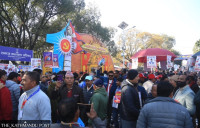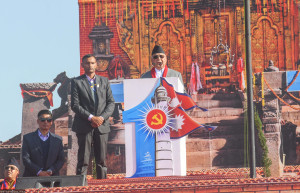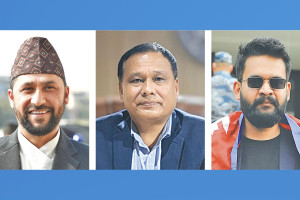Politics
‘Navin RPP’ campaign aims to attract youth to the party
Royalist party pledges 33 percent women participation and lateral entry to its committees.
Tika R Pradhan
With an objective to attract the new generation to the major pro-monarch force of the country, Rastriya Prajatantra Party has started a ‘Nabin [New] RPP’ campaign.
However, political analysts say attracting youths to the rightist force could be challenging.
The RPP led by Rajendra Lingden, who defeated party veteran Kamal Thapa to become its president from the general convention in December 2021, has won 14 seats in the lower house which is a significant rise compared to the 2017 polls when Lingden was the only lawmaker from the party.
While the incumbent chiefs of three big parties—Nepali Congress, CPN-UML and CPN (Maoist Centre)—got continuity to the posts, RPP was the one to elect a new leader.
RPP leaders said during the latest general convention there were 160,000 active members. Now the party has set a target of making 200,000 active members within a year.
“The very motive is to strengthen the party organisation, bolster internal democracy and establish the RPP as the party of the general people,” said Sagun Lawoti, the party spokesman. “We basically wish to build a Nepal where the new generation can work and thrive in the country, without having to go abroad in search of jobs.”
The party’s central working committee meeting held on May 15-17 endorsed the 21-point ‘New RPP Workplan 2023’ prepared by senior vice-chair Rabindra Mishra, and vice-chair duo Hemjung Gurung and Uddwav Poudel. The plan was revealed by party chair Lingden on Thursday after a revision.
Among the party’s then candidates, only Rajendra Lingden, the incumbent Rastriya Prajatantra Party chair, won the elections, from Jhapa-3. The party couldn’t cross the three percent threshold to qualify for Proportional Representation (PR) seats.
RPP’s debacle in the 2017 general elections prompted different pro-monarchy parties to eventually merge, in 2020, to form the unified Rastriya Prajatantra Party.
Hurt by his defeat to a junior leader in the race, Thapa quit the party and regrouped his supporters under the old Rastriya Prajatantra Party-Nepal.
While Thapa’s party faced a debacle in the local polls and the general elections that followed, Lingden’s performed far better winning more seats at all three levels.
The party has 28 seats in a total of 550 seats of all seven provinces and four mayors/chairs among the 753 local units.
Now, with the rise of newer parties like the Rastriya Swatantra Party due to the growing frustrations among youths towards the larger parties, which also benefited the RPP, the royalist party wants to develop it as an alternative to the Congress, the CPN-UML and the CPN (Maoist Centre).
As part of this campaign, all the central working committee members are deployed to the local units for the next six months and are asked to update the party online on their activities.
According to party leaders, as many as 50 percent of the candidates for the next polls will be elected from the primary.
Earlier, the CPN-UML, the second largest party in the federal parliament, had also taken similar steps to strengthen the party through its ‘mission grassroots’, even though it did not help the party much in the by-elections held immediately after the campaign.
The RPP leaders, however, claimed that they want to develop the party as an alternative to the big parties citing the amount of public frustration towards them.
“Actually, we want to attract youths who are frustrated by the age-old working style of larger parties,” Lawoti told the Post. “We want to give RPP a new lease of life and make it a centre of attraction for the youths.”
He said ‘the new RPP’ has something to offer to attract different sections of the society. “For instance our working plan guarantees 33 percent women’s participation and lateral entry for youth under the age of 40 in all party structures, from the ward to the central committee,” he explained.
Though the party leaders are hopeful that their plan would get traction, some political analysts don’t buy the argument. They said that Nepali youths are not in a position to adopt the old monarchy and have gone very far away from it.
“Nobody believes the royalist party as an alternative to the existing progressive parties at a time when some other newer parties have already attracted the youths from the Congress and the UML,” said Uddav Pyakurel, a political analyst. “I think the RPP can revitalise its own rank and file but cannot become an alternative with the ideology it has adopted.”
Pyakurel said Nepali youths aspire for a system which is far ahead of what the existing parties have thought of but RPP wants them to accept the age-old and outdated monarchy which is not possible.




 8.12°C Kathmandu
8.12°C Kathmandu













